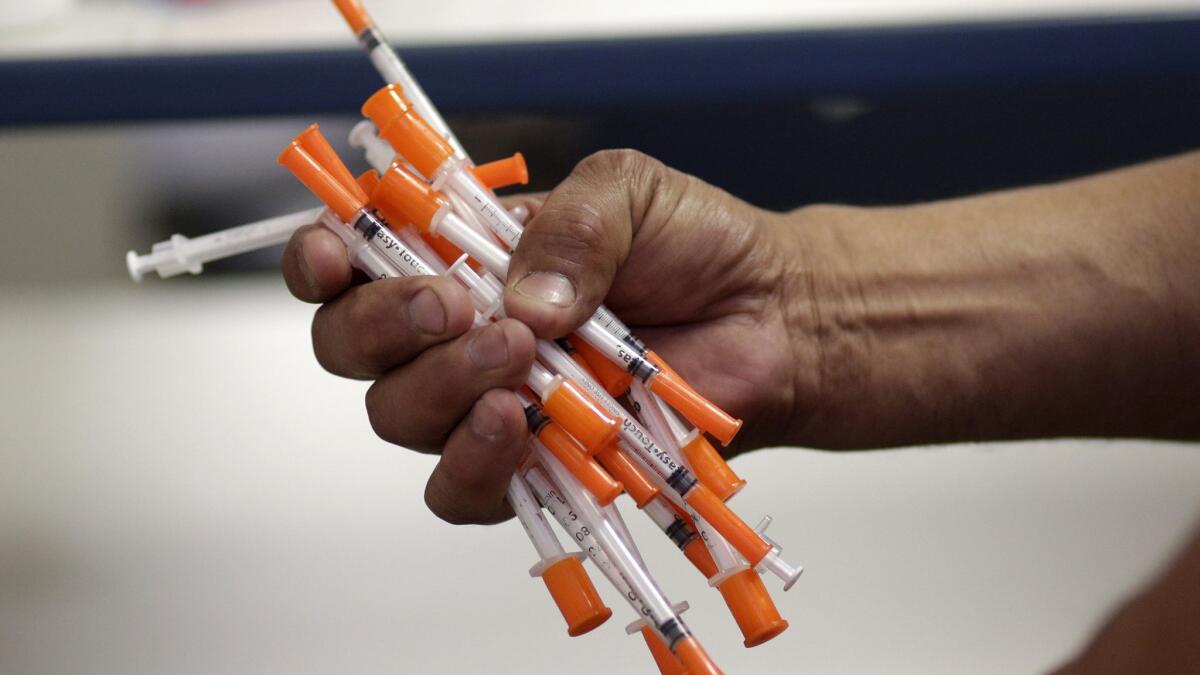Commentary: We need supervised consumption sites, not needle exchange programs

- Share via
The recent court order setting back the effort for mobile needle exchange programs in Orange County demonstrates the push back for needle exchange programs more generally from county and city authorities.
Part of that push back might be because, at least in Orange County, those needle exchange programs are the wrong strategy for combating the ongoing opioid epidemic.
Needle exchange programs often lead to significant increases in needle litter, fail to reduce overall substance abuse and paradoxically lead to worse outcomes for those using the services because of the lack of safe consumption spaces.
Everyone agrees that substance abuse is a growing problem in our community, but the real question is determining the best way to combat the problem -- that is, how can we reduce the harm for both substance abusers and our community in a fair and cost-effective manner?
One of the best ways may be through creating supervised consumption sites. Supervised consumption sites are associated with fewer discarded needles in public areas.
They can help prevent accidental deaths and reduce the transmission of HIV and hepatitis. These sites allow people struggling with addiction to bring in pre-obtained controlled substances into a space with health care professionals and the supplies necessary to prevent a fatal overdose. They increase access to substance use treatment and referrals for persons; simply put, it keeps them alive so they can decide to start on a path to recovery.
People who inject substances have a significantly increased risk for exposure to and acquisition of blood-borne infectious diseases. That is demonstrated by the high incidence of new hepatitis C and HIV infections.
Orange County, Los Angeles, San Bernardino, Riverside, and San Diego have high numbers of new HIV diagnoses. There are 7,262 persons estimated to be HIV-infected in OC in 2018, with 88% of diagnosed.
Among females in Calfiornia, 17.2% of new HIV cases were attributed to injection drug use. Hepatitis C infection rates in California are higher than the national average, with O.C. being identified as vulnerable to transmission of hepatitis C and HIV. High overdose rates in this county can be reduced through the implementation of supervised consumption sites.
Addiction is rampant in our country, with rates of overdose increasing. Current policies are not working, showing that we need change. It’s time we re-frame this issue from a criminal justice safety approach to emphasizing harm reduction.
Instead of treating loved ones and neighbors who have substance-use disorders as criminals, we should look at them as patients in need of medical care. Substance use disorders should be shifted from being a police issue to a public health issue where a person would advocate for patients’ autonomy in treatment and recovery.
Changing how we combat the opioid epidemic would help combat rising rates of injection drug use, overdose and blood-borne acquired infections. Supervised consumption sites are focused on prevention and rooted in economically valid evidence-based practices.
This will help people with substance use disorder enter into addiction recovery treatment. Given the current synergistic HIV/AIDS and opioid epidemics, there is a magnification of the consequences surrounding injection substance use.
In short, to combat the opioid epidemic and substance abuse-related health problems, we should think more seriously about supervised consumption sites, not necessarily focusing on needle exchange programs.
Huntington Beach resident Lois Nestor is working toward a master’s degree in public health at Boston University’s School of Public Health.
All the latest on Orange County from Orange County.
Get our free TimesOC newsletter.
You may occasionally receive promotional content from the Daily Pilot.



